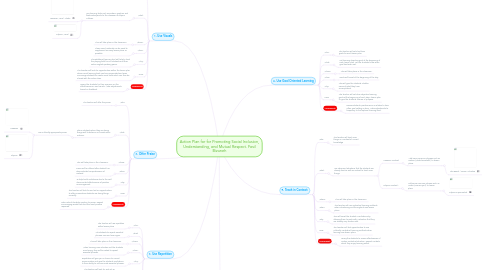
1. 1. Use Visuals
1.1. Who:
1.1.1. The teacher will supplement course material with visual learning tools
1.2. What:
1.2.1. Use learning tools such as posters, graphics and flashcards specific to the Hawaiian & Filipino cultures.
1.2.1.1. Hawaiian Visual - Shaka
1.2.1.2. Filipino Visual
1.3. Where:
1.3.1. This will take place in the classroom.
1.4. When:
1.4.1. These visual materials can be used to supplement as many lesson plans as possible.
1.5. Why:
1.5.1. This additional learning tool will help to level the playing field for ELL students and their native english speaking peers.
1.6. How:
1.6.1. The teacher will look for opportunities within the lesson plan where visual learning tools can be incorporated and even encourage students to create visual tools which can then be shared with the entire class.
1.7. Assessment
1.7.1. Query the students for their opinions on the effectiveness on said visuals. Make adjustments based on feedback.
2. 2. Offer Praise
2.1. Who:
2.1.1. The teacher will offer the praise
2.2. What:
2.2.1. Inform students when they are doing things well to balance out constructive criticism.
2.2.1.1. Use Culturally appropriate praise.
2.2.1.1.1. Hawaiian
2.2.1.1.2. Filipino
2.3. Where:
2.3.1. This will take place in the classroom.
2.4. When:
2.4.1. Praise will be offered after student has demonstrated comprehension of material.
2.5. Why:
2.5.1. To help build confidence due to the well documented effectiveness of positive encouragement.
2.6. How:
2.6.1. The teacher will look for and act on opportunities to offer praise when students are doing things correctly.
2.7. Assessment:
2.7.1. Take note of students reaction to praise. Repeat encouraging words that elicit the most positive response.
3. 3. Use Repetition
3.1. Who:
3.1.1. The teacher will use repetition within lesson plans
3.2. What:
3.2.1. Ask students to repeat essential phrases over and over again.
3.3. Where:
3.3.1. This will take place in the classroom.
3.4. When:
3.4.1. When learning new activities and the students are sharing, they will be asked to repeat essential phrases.
3.5. Why:
3.5.1. Repetition will give you a chance to correct pronunciation and give the students confidence in their ability to communicate essential phrases.
3.6. How:
3.6.1. The teacher will look for and act on opportunities to ask students to repeat themselves when speaking essential phrases.
3.7. Assessment:
3.7.1. Review student's performance in relation to how often repetition is used. Make adjustments to frequency to find optimal learning level.
4. 4. Use Goal Oriented Learning
4.1. Who:
4.1.1. The teacher will set short term goals for each lesson plan.
4.2. What:
4.2.1. Set learning objective goal at the beginning of each lesson plan. Let the studnets know when goal has been met.
4.3. Where:
4.3.1. This will take place in the classroom.
4.4. When
4.4.1. Goals will be set at the beginning of the day.
4.5. Why:
4.5.1. This will give the students a better sense of what they have accomplished.
4.6. How:
4.6.1. The teacher will set clear objective learning goals at the beginning of each day's lesson plan to give the students a sense of purpose.
4.7. Assessment:
4.7.1. Review student's performance in relation to how often goal setting is done. Make adjustments to frequency to find optimal learning level.
5. 5. Teach in Context:
5.1. Who:
5.1.1. The teacher will teach new things in a context of current knowledge
5.2. What:
5.2.1. Use ideas and situations that the students are already familiar with as context to teach new things.
5.2.1.1. Hawaiian Context
5.2.1.1.1. Add some common phrases such as Dakine (Whatchamacallit) to lesson plans.
5.2.1.2. Filipino Context -
5.2.1.2.1. Add some common phrases such as Musta (How are you) to lesson plans.
5.3. Where:
5.3.1. This will take place in the classroom.
5.4. When:
5.4.1. The teacher will use contextual learning methods when introducing and throughout new lesson plans
5.5. Why:
5.5.1. This will boost the student's confidence by allowing them to work with a situation that they are already very familiar with.
5.6. How:
5.6.1. The teacher will find opportunities to use culturally contextual learning methods when forming new lesson plans.
5.7. Assessment:
5.7.1. Query the students to assess effectiveness of certain contextual situation. Repeat contexts which they enjoy learning within.

